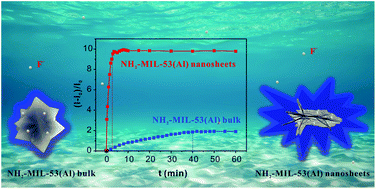Fluoride sensing performance of fluorescent NH2-MIL-53(Al): 2D nanosheets vs. 3D bulk†
Abstract
Due to their ultra-thin morphology, larger specific surface area and more exposed active sites, two-dimensional (2D) metal–organic framework (MOF) nanosheets can break the limitations of three-dimensional (3D) MOFs in sensitivity, response speed and the limit of detection for sensing applications. In this work, fluorescent NH2-MIL-53(Al) nanosheets were developed as a fluoride detection sensor compared with the 3D bulk counterpart. The morphological and structural characteristics of the obtained products were systematically characterized, and the favourable chemical and fluorescence stability of the NH2-MIL-53(Al) nanosheets were explored. The fluorescent NH2-MIL-53(Al) nanosheets showed high sensitivity, fast response speed (as short as 10 seconds), low limit of detection (15.2 ppb), and wide linear detection range (5–250 μM), and all performances were better than those of their bulk counterpart. In addition, the sensing mechanism was investigated to be based on the transformation of the NH2-MIL-53(Al) framework that induced the release of fluorescent ligands, resulting in an exceptionally enhanced fluorescence. This work highlights the advantages of 2D MOF nanosheets in fluorescence sensing applications.



 Please wait while we load your content...
Please wait while we load your content...